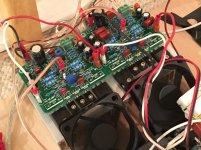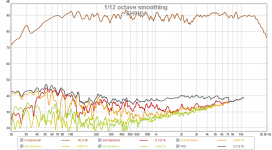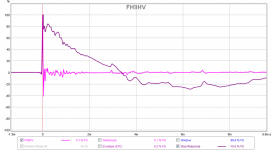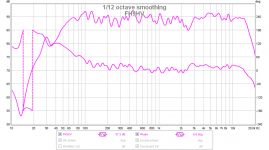So you can sufficiently drive MOSFET gates directly with input sk170/sj74? This is sort of like an M2 sans transformer? What is the gain you are getting here?
The only pairs from that seller that are affordable are the unmatched pairs.
The matched pairs look to be expensive.
Which is required?
I have not tried with matched pair so you should get the same result as I but you need at least the same grade "Y" for vgsoff to ensure sufficient symmetry and also enough open loop gain.
I do not recall Nelson Pass requiring matching for the F5. Anyway matching is usually more imperative for paralleling devices.
However, the input jeft should have a minimum matching....but a little 2nd harmonic is not bad anyway...
Fab
Last edited:
So you can sufficiently drive MOSFET gates directly with input sk170/sj74? This is sort of like an M2 sans transformer? What is the gain you are getting here?
Yes as it is the case for F5 amplifier.
You mean open loop gain or close loop one?
Open loop gain is roughly about 55 to 60 db but depends on vgsoff of output trannies and bias current and the speaker load impedance.
Close gain is about 10 or 20db.
The thermistors are not optional as in the F5 but imperative to keep the temperature stability because the source resistor value at output stage is low.
Fab
Last edited:
I have not tried with matched pair so you should get the same result as I but you need at least the same grade "Y" for vgsoff to ensure sufficient symmetry and also enough open loop gain.
I do not recall Nelson Pass requiring matching for the F5. Anyway matching is usually more imperative for paralleling devices.
However, the input jeft should have a minimum matching....but a little 2nd harmonic is not bad anyway...
Fab
Hi ammel68
I know a good source Where you can get 2 X N et 2 X P (quad) for 40$ US plus shipping (but free shipping in USA). Just PM me if you are interested for the web address.
Fab
Last edited:
Just an update on the M2. I built a simple little 6 transistor preamp from Apex Audio and it works real well to get me 10dB gain and is quite transparent. Doesn't add or detract from signal. Speakers and M2 amps sound good together with this preamp.
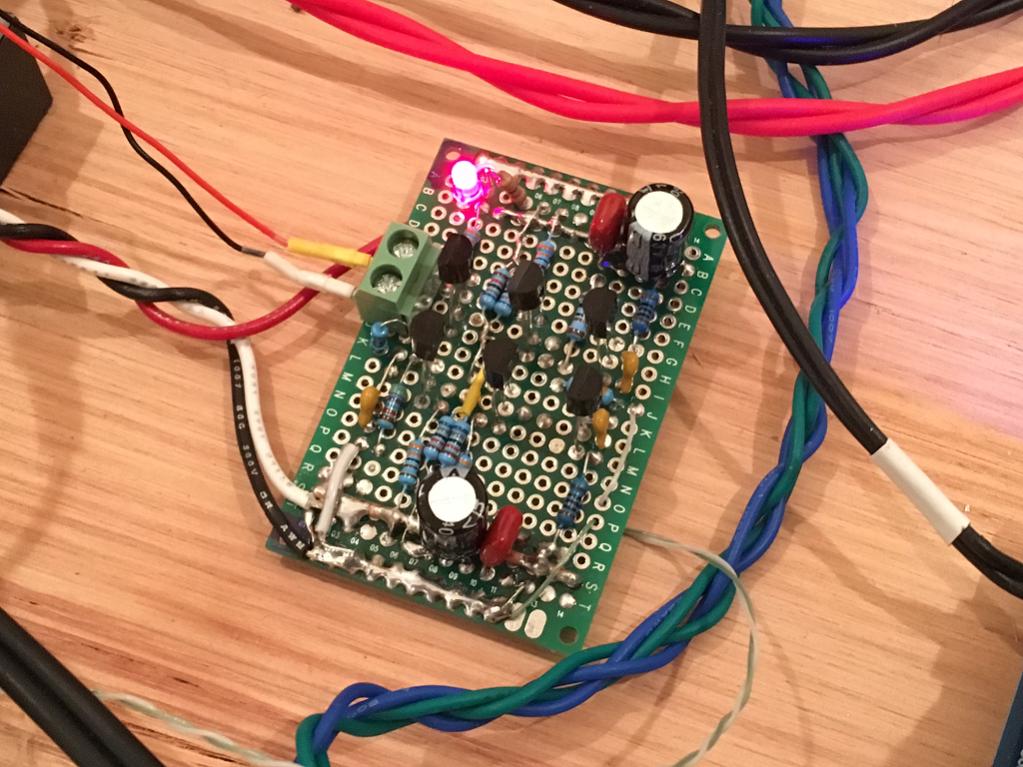
More info here:
http://www.diyaudio.com/forums/solid-state/296144-transistor-preamp-10.html

More info here:
http://www.diyaudio.com/forums/solid-state/296144-transistor-preamp-10.html
FH9HV Sound Clips
After hearing from another member who just built some FH9HV's and he said that they sound so good. I had a thought that maybe they might actually sound different (better) than the FH9 as they use KSA1381/KSC3503's which are higher performing than BD139/140's. So out went the M2's and in went the FH9HV's with the 300VA 32v trafo for 44v rails. PSU ripple with amps connected (140mA bias current) is 20mV.
Here is the amp - runs way cool with the two fans:
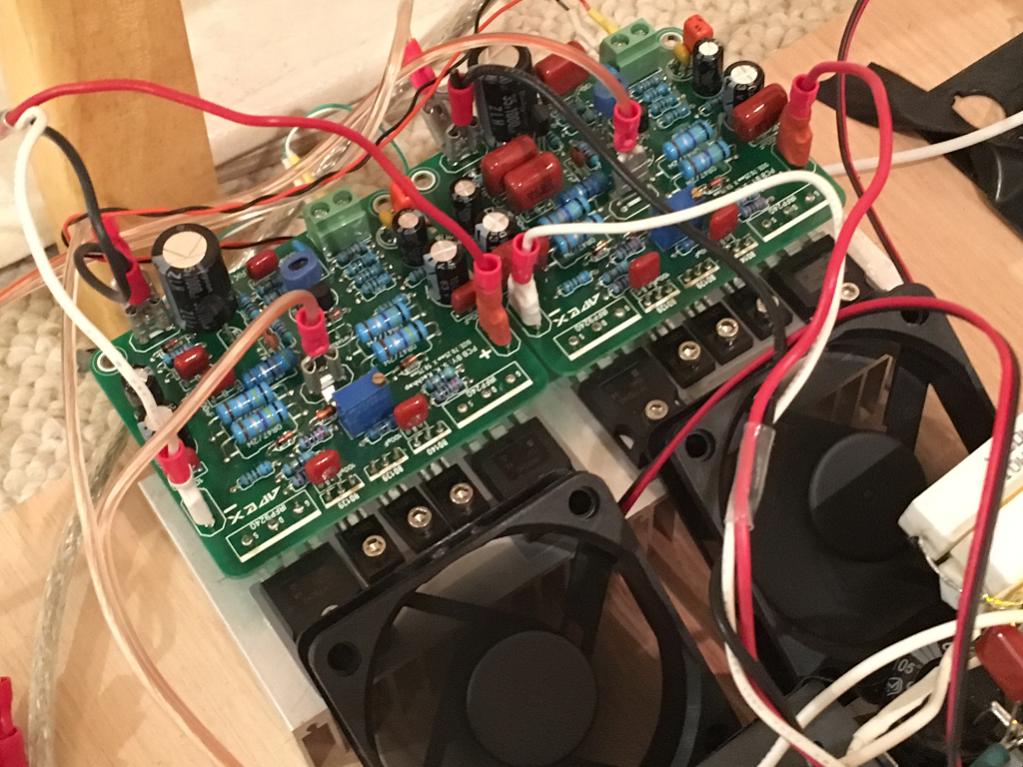
They immediately sound better than the M2's to my ears. Lower distortion, more snap on transients, more clear mid bass (less muddy) and beautifully resolved mids and vocals. I really like this amp - I think it is one of the best actually that I have tested.
Measurements reveal half the distortion of the M2 in the bass region and lower distortion at 1kHz even. The class A did not buy much for me in this case (except a lot of extra heat in the room):
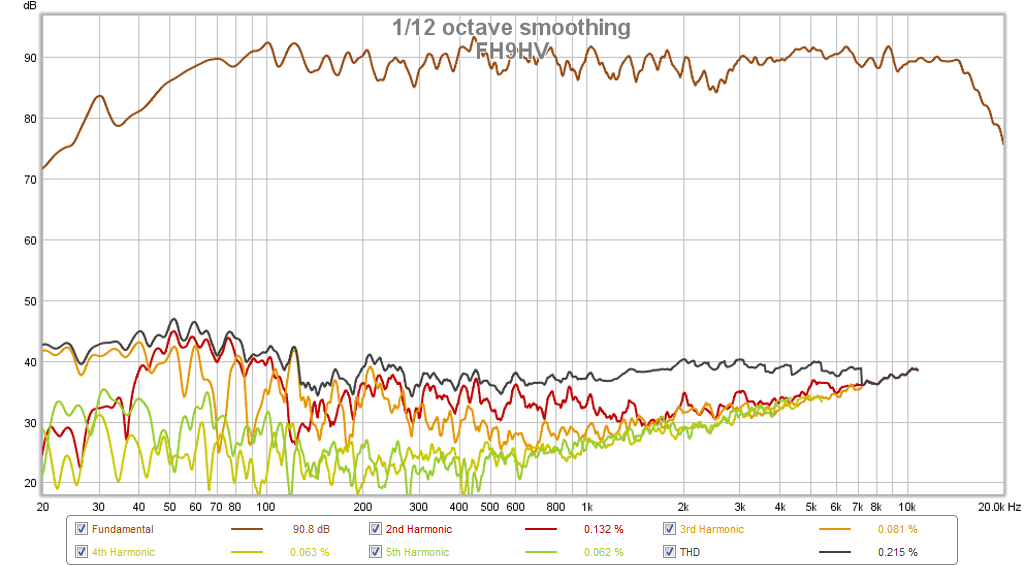
Here is measured Impulse and Step Response:
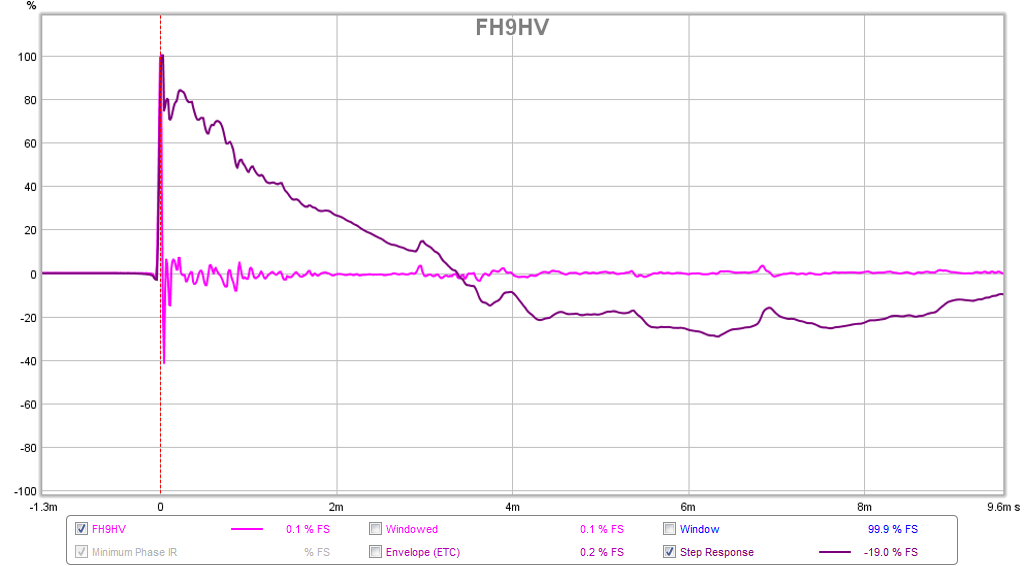
Here is measurered Phase and Freq Response:
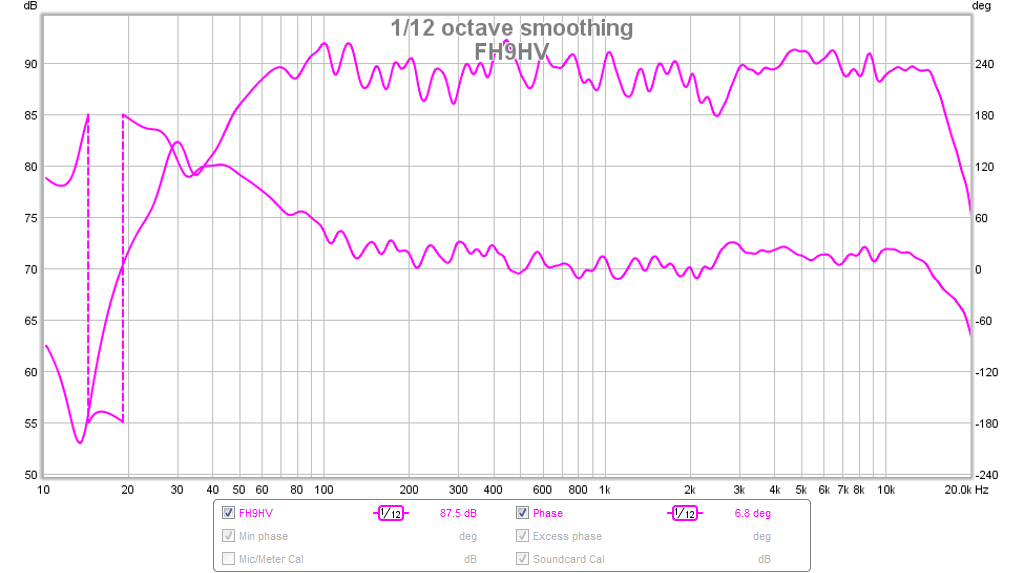
So I went ahead and recorded the same sound clips for everyone to listen for themselves. Change extension from .asc to .mp3 to listen.
After hearing from another member who just built some FH9HV's and he said that they sound so good. I had a thought that maybe they might actually sound different (better) than the FH9 as they use KSA1381/KSC3503's which are higher performing than BD139/140's. So out went the M2's and in went the FH9HV's with the 300VA 32v trafo for 44v rails. PSU ripple with amps connected (140mA bias current) is 20mV.
Here is the amp - runs way cool with the two fans:

They immediately sound better than the M2's to my ears. Lower distortion, more snap on transients, more clear mid bass (less muddy) and beautifully resolved mids and vocals. I really like this amp - I think it is one of the best actually that I have tested.
Measurements reveal half the distortion of the M2 in the bass region and lower distortion at 1kHz even. The class A did not buy much for me in this case (except a lot of extra heat in the room):

Here is measured Impulse and Step Response:

Here is measurered Phase and Freq Response:

So I went ahead and recorded the same sound clips for everyone to listen for themselves. Change extension from .asc to .mp3 to listen.
Attachments
Last edited:
I have to confirm what xrk971 is saying, it is really a good sounding amplifier, actually much more than I thought it would ever be. I gave it several hours of burn in and when actually sat down to listen to it I was impressed. The soundstage is incredibly wide which adds to the realism of the presentation. The render is spacious and instruments breath very well, it has a very natural flow. So far, I have not seen aggressive behaviors in the highs. Bass is fast and punchy. As xrk971 wrote, it has "beautifully resolved mids and vocals".
I will do more listening tests in the coming days. I will be losing my USSA2 amplifier for a couple weeks while I complete my USSA5 so I'll have this very nice amplifier to listen to. It is definitely a keeper!
Thanks
Do
I will do more listening tests in the coming days. I will be losing my USSA2 amplifier for a couple weeks while I complete my USSA5 so I'll have this very nice amplifier to listen to. It is definitely a keeper!
Thanks
Do
xrk971,
I see you're putting small caps on the collector and base of the KSA1381/KSC3503 pair, is it due to some oscillation? Do we need them? If yes, what's the value and type?
Thanks
Do
I see you're putting small caps on the collector and base of the KSA1381/KSC3503 pair, is it due to some oscillation? Do we need them? If yes, what's the value and type?
Thanks
Do
xrk971,
I see you're putting small caps on the collector and base of the KSA1381/KSC3503 pair, is it due to some oscillation? Do we need them? If yes, what's the value and type?
Thanks
Do
Those were recommended by Apex Audio (Mile Slakovic) in the design and value is shown on PCB as 100pF. Best would be NP0/C0G ceramic/silver mica/film caps. I am currently using CBB 100pF (5%) 100v MKT film there. I have not tried running without it so can't say if it will suffer oscillations or not - I believe not as Andrew Lebon built and ran a version before it was recommended. Probably good idea to keep stability over wide range of loads.
Last edited:
I have to confirm what xrk971 is saying, it is really a good sounding amplifier, actually much more than I thought it would ever be. I gave it several hours of burn in and when actually sat down to listen to it I was impressed. The soundstage is incredibly wide which adds to the realism of the presentation. The render is spacious and instruments breath very well, it has a very natural flow. So far, I have not seen aggressive behaviors in the highs. Bass is fast and punchy. As xrk971 wrote, it has "beautifully resolved mids and vocals".
I will do more listening tests in the coming days. I will be losing my USSA2 amplifier for a couple weeks while I complete my USSA5 so I'll have this very nice amplifier to listen to. It is definitely a keeper!
Thanks
Do
Thanks for the feedback Do. I am certain that this amp deserves a real box now - that's a clear sign it's a keeper and one of the best in my collection. 🙂
Those were recommended by Apex Audio (Mile Slakovic) in the design and value is shown on PCB as 100pF. Best would be NP0/C0G ceramic/silver mica/film caps. I am currently using CBB 100pF (5%) 100v MKT film there. I have not tried running without it so can't say if it will suffer oscillations or not - I believe not as Andrew Lebon built and ran a version before it was recommended. Probably good idea to keep stability over wide range of loads.
Ah... Sorry I have those in place... It was just the photo perspective seemed like they were soldered directly on the pins of the KSA1381/KSC3503 but it is just because you didn't yet cut the leads.
Sorry!
Do
FH9HV Review
I agree with X and Pinnocchio. When I played the clip#3 I immediately knew that this is very good. Contrast to FH9 that was so distorted.
The FH9HV reminds me of my main criteria in building amps/speakers... Long ago I tried to understand what physical parameters are responsible with enjoyment in music listening. The number one answer was "drive"/"sonic"/"dynamic" (and the absence of "fatigue")... Everything else is just "nice to have"...
The FH9HV has perfect "drive". It makes fast instruments pitch and rhythm so "fluent" (Pinnocchio uses the words "natural flow"). It makes me want to sing along, loudly!
The weakness is still obvious, it cannot equal LATFET in certain area, which I have to say is just "nice to have". The FX8 (with LATFET) is so much "richer". But I have always wanted LATFET amp to reach 90% of what the HEXFET or BJT are capable of. FX8 has the minimum drive that I can accept from LATFET and I'm still finding a way to improve this. Most of the time, latfet amps are disappointment 😀
Audio is about preference...
They immediately sound better than the M2's to my ears. Lower distortion, more snap on transients,
I agree with X and Pinnocchio. When I played the clip#3 I immediately knew that this is very good. Contrast to FH9 that was so distorted.
The FH9HV reminds me of my main criteria in building amps/speakers... Long ago I tried to understand what physical parameters are responsible with enjoyment in music listening. The number one answer was "drive"/"sonic"/"dynamic" (and the absence of "fatigue")... Everything else is just "nice to have"...
The FH9HV has perfect "drive". It makes fast instruments pitch and rhythm so "fluent" (Pinnocchio uses the words "natural flow"). It makes me want to sing along, loudly!
The weakness is still obvious, it cannot equal LATFET in certain area, which I have to say is just "nice to have". The FX8 (with LATFET) is so much "richer". But I have always wanted LATFET amp to reach 90% of what the HEXFET or BJT are capable of. FX8 has the minimum drive that I can accept from LATFET and I'm still finding a way to improve this. Most of the time, latfet amps are disappointment 😀
Audio is about preference...
So Jay,
You are still a little on the fence here... is the FH9HV now the king of amps in this lineup or is it still the FX8 Bimo mod? Both have same KSA/KSC drivers - just difference in latFETs vs hexFETs.
Thanks for your feedback though. In any event, after having done this virtual audition - I do seem to think I have found quite the gem in the little FH9HV, an unassuming inexpensive little amp that seems to do so much so well.
You are still a little on the fence here... is the FH9HV now the king of amps in this lineup or is it still the FX8 Bimo mod? Both have same KSA/KSC drivers - just difference in latFETs vs hexFETs.
Thanks for your feedback though. In any event, after having done this virtual audition - I do seem to think I have found quite the gem in the little FH9HV, an unassuming inexpensive little amp that seems to do so much so well.
Thanks for the feedback Do. I am certain that this amp deserves a real box now - that's a clear sign it's a keeper and one of the best in my collection. 🙂
It will most likely go into the nice chassis of my very old dual LM4780. It is a well designed chassis and has a good PSU for it. I will however try my 1200W +/-55Vdc SMPS before I settle on which one I prefer. I also have in the chassis, the AMB LCDuino-1, δ1 relay-based R-2R stereo attenuator and a Borbely EB-604 / 410. If not a good match, I will flush them from the chassis.
Ciao!
Do
So Jay,
You are still a little on the fence here... is the FH9HV now the king of amps in this lineup or is it still the FX8 Bimo mod?
That's why I wrote: Audio is about preference... 🙂 Ideally I want all the goods from both amps.
Which one is my preference? I don't know, I have never talked about preference with amps because since decades ago, I have always wanted a latfet amp to finally perform.
And I will build the amps with its variations. Only then I might be able to say which one I prefer... 😀
That's why I wrote: Audio is about preference... 🙂 Ideally I want all the goods from both amps.
Which one is my preference? I don't know, I have never talked about preference with amps because since decades ago, I have always wanted a latfet amp to finally perform.
And I will build the amps with its variations. Only then I might be able to say which one I prefer... 😀
I already modify again my FX8 modification. I add buffer for latfet, so VAS's current can be lower (about 5mA). In simulation, I can reduce the THD.
I already modify again my FX8 modification. I add buffer for latfet, so VAS's current can be lower (about 5mA). In simulation, I can reduce the THD.
Can you share schematic and layout? This would make it 10 active devices then? I wonder if doubling up the latFETs might help improve transconductance to be snappier like hexfet?
I already modify again my FX8 modification. I add buffer for latfet, so VAS's current can be lower (about 5mA). In simulation, I can reduce the THD.
Hi Bimo,
Just as an idea, if you can get those devices somehow - an excellent buffer pair would be the FETs like 2SK2013 / J313.
Ciss is 170pF / 210pF respectively, practically independent from the drain-source voltage (unless it's getting very small). Great drivers - you can go for 2-3 pairs of the outputs easily then.
The other good pair is 2SK2381 / J407.
Unfortunately, all of them are very difficult to obtain these days...
Cheers,
Valery
Don't know if any good but appears to be available from here;
http://www.aliexpress.com/item/32678655869/32678655869.html
"Free shipping K2013 J313 audio amplifier paired pipe 2SK2013 2SJ313 Original Product"
http://www.aliexpress.com/item/32678655869/32678655869.html
"Free shipping K2013 J313 audio amplifier paired pipe 2SK2013 2SJ313 Original Product"
Don't know if any good but appears to be available from here;
http://www.aliexpress.com/item/32678655869/32678655869.html
"Free shipping K2013 J313 audio amplifier paired pipe 2SK2013 2SJ313 Original Product"
I'm almost certain they will be fake on Aliexpress since they're "precious" obsolete parts. You can buy originals from forum members if you post in the swap meet.
Ciao!
Do
- Status
- Not open for further replies.
- Home
- Amplifiers
- Solid State
- Virtual Audition of Very Simple Quasi MOSFET Amp
